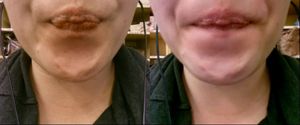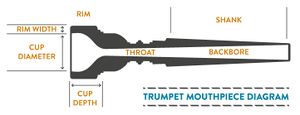Course:PHYS341/Archive/2016wTerm2/How embouchure effects your sound: Brass
The word 'embouchure' is derived from the French word “bouche”, meaning “mouth”, for some obvious reasons. An embouchure is the positioning and usage of a musician’s facial muscles, particularly in terms of how the musician shapes his or her mouth and lips to the mouthpiece of an instrument; for the purposes of this article, the mouthpiece of a brass instrument. The embouchure used for brass instruments is particularly important, as it is what facilitates the production of sound when playing, and there are many variables that contribute to a brass player achieving a rich tone and full range, without straining their facial muscles.3

The Buzz
The 'buzz', or vibration of the lips is one of the most crucial steps for producing sound on a brass instrument, and is achieved through a player’s embouchure and air support. In other words, A (Air) + E (Embouchure) = T (Tone). [1] When initially learning how to play a brass instrument and form their embouchure, a player will learn to focus tension in the muscles surrounding the mouth, particularly the corners of the lips, in order to avoid putting too much tension on the lips themselves. Though there will inevitably be some tension left in the lips, it is important to keep them as relaxed as possible (especially towards the centre) enough for them to vibrate or ‘buzz’, which creates an opening and closing motion in of the lips that regulates the air flow to the effect of 'puffs' or 'pulses'. Alongside the pulses of air, the vibration of the lips create a resonance within and along the mouthpiece that is carried throughout the instrument by the expelled air.

Some instructors may describe the general shape of an embouchure to the effect that the inner mouth is held as if the player were to say 'oh' and the lips as though they were to shape 'em', which the chin flat underneath the lower lip, and pointed towards the bottom of the chin. However, this may vary from player to player, as much of the shaping of the embouchure, placement of the mouthpiece, and increase & decrease of tension depend on not only which instrument the musician plays (ex: french horn, cornet, trumpet, trombone, euphonium, tuba, etc.) but also the musician's own anatomy (most common variants are the teeth and lips). Though there will inevitably still be some tension in the lips, it is important to keep them as relaxed as possible (especially towards the centre) enough for them to vibrate (or ‘buzz’), which regulates the air flow to the effect of 'puffs' or 'pulses'. Alongside the pulses of air, the vibration of the lips create a resonance within and along the mouthpiece that is carried throughout the instrument by the expelled air.
Variables
Mouth and Lip: Placement and Shape
A mistake that many new players make is to press the mouthpiece too firmly against their lips in order to compensate for the lack of tension in their facial muscles in attempt to reach higher notes; this results in the formation of a red ring (“pressure ring”), swollen lips, and even bruises where the mouthpiece was placed. In addition, the resulting sound has a thin tone in the upper registers, and if maintained for too long, the player may end up being unable to produce any sort of sound, which is why this technique is often discouraged in the earlier stages of learning to play a brass instrument (though it is used to a certain degree by some professionals, within reason). [2] The lack of pressure on the lips is to avoid cutting off blood circulation and injury, as well as to allow a musician to maximize their playing endurance, while the tensed muscles surrounding the mouth (and the lips) are what aid in tone and pitch manipulation.
There is also the physical variable of teeth. In a case where a player has an overbite, or perhaps for some other reason (orthodontic or otherwise), a brass player may be inclined to play with a certain kind of embouchure placement over another (ex. lower, higher, angled downward/upward, etc.). If this embouchure placement effects the musician's playing in a detrimental manner, such as placing too much pressure on the lips, limiting their range or compromising their tone, a common way to remedy the problem, or at least improve the situation is to find a better fitting mouthpiece. This can also be said for players which wish to create a specific effect/sound, often times as they increase their level of expertise. Though there are no exact ways to find the 'perfect' mouthpiece, there are some components that can potentially narrow down the search.
Mouthpiece

In general, brass mouthpieces have the same components of a rim, cup cavity, throat, backbore, and shank. The rim is often varied in terms of width, which can effect how much of the lips are free to buzz and the roundness or sharpness, which respectively help in comfort or more articulated attacks, both qualities (width and contour) lending themselves to effecting the musician's overall endurance either positively or poorly. For the cup cavity, a deeper cup with its larger space, tends to lend itself well to a darker, mellow, and richer tone, while a shallow cup often aids in a brighter tone, and may help a player reach a higher register, with pros and cons dependant on the player. The throat, which is at times referred to as the "backbore", is where the air itself passes through into the instrument. A wider throat may lend itself to a bigger, more rounded sound, as it allows more air to pass through, while a narrower throat with its increased air-resistance, may help create a brighter sound and help a learning player work on their endurance. The shank is the part of the mouthpiece that rests inside the instrument and passes on the resonance created by the player and the mouthpiece.[3]
Style/Genre of Music
In general, an orchestral brass player may gravitate towards a rounded or sharp rimmed mouthpiece, with deeper cup cavity, and a more open backbore, for a richer, fuller sound and the ability to express a wide range of dynamics, while a jazz musician may lean towards a rounded or sharp rimmed mouthpiece, with a shallower cup cavity, more narrow backbore to achieve the classic bright brassy sound of a lead trumpet player. Though this will vary depending on a musician's taste.
In Practice
Exercises
Some exercises that can be used to help increase endurance and strengthen the muscles used in an embouchure, are sustaining long, even notes, with an acute effort to maintain a rich tone that is as unwavering as possible. For higher notes, it is important to practice with a focus on maintaining relaxed lips and putting just enough pressure on the mouthpiece to avoid allowing air to escape at the corners of the mouth.
Technical Skills / Effects
Bending notes is a practice of both using the vocal tract to effect the air flow, smoothly increasing or decreasing tension in the embouchure, and using the lips to manipulate the direction of the air flow.
Summary
There are many parts to that contribute to the whole known as an "embouchure", and depending on what sound a musician desires to achieve, it is greatly a matter of trial and error to find the embouchure that suits their needs.
See Also
- https://en.wikipedia.org/wiki/Brass_instrument
- https://en.wikipedia.org/wiki/French_horn
- https://en.wikipedia.org/wiki/Cornet
- https://en.wikipedia.org/wiki/Trumpet
- https://en.wikipedia.org/wiki/Trombone
- https://en.wikipedia.org/wiki/Euphonium
- https://en.wikipedia.org/wiki/Baritone_horn
- https://en.wikipedia.org/wiki/Tuba
- https://en.wikipedia.org/wiki/Embouchure#Brass_embouchure
References
- ↑ Pearson, Bruce. "Teaching the Brass Embouchure." Teaching the Brass Embouchure. Kjos Band News, n.d. Web. 03 Apr. 2017.
- ↑ Gale, Bruce. "Common Embouchure Problems." The Concert Band, n.d. Web. 03 Apr. 2017.
- ↑ Jacobson, Bob. "Trumpet Mouthpiece Primer: Finding the Best Match for Your Chops." Reverb.com. Reverb, 27 Jan. 2016. Web. 6 Apr. 2017.
Further Reading
- http://www.kjos.com/band/band_news/band_news_emb4.html
- http://www.wilktone.com/?p=12
- http://theconcertband.com/index.php/resources/instruments/brass/common-embouchure-problems
- http://www.bbtrumpet.com/embouchures.html
- http://www.brasstutorials.com/forming-the-embouchure.html
- https://www.hornsociety.org/publications/horn-call/online-articles/148-embouchure-health-a-maintenance
- http://brassembouchure.weebly.com/horn.html